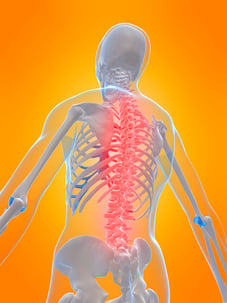Osteoporosis is a disease in which the bones become weak and brittle and more likely to break in a fall. With osteoporosis, the normal process of creating new bone cells and reabsorbing the old cells becomes impaired. Bone loss is more rapid than bone growth, leading to the gradual thinning of the bone.
 It is believed an estimated 80% of people who have a spinal cord injury will experience osteoporosis or osteopenia (an intermediate bone-density loss which is not as fragile as osteoporosis). Signs of osteoporosis can be seen as early as six weeks post injury. For people who have a spinal cord injury, osteoporosis can occur due to many different factors, such as lack of weight bearing, sluggish blood flow to the limbs, and poor diet.
It is believed an estimated 80% of people who have a spinal cord injury will experience osteoporosis or osteopenia (an intermediate bone-density loss which is not as fragile as osteoporosis). Signs of osteoporosis can be seen as early as six weeks post injury. For people who have a spinal cord injury, osteoporosis can occur due to many different factors, such as lack of weight bearing, sluggish blood flow to the limbs, and poor diet.
A DEXA scan is a bone mineral density test; a score resulting from the scan is compared to that of a young, healthy person. A comparison of your score to that score will determine if you have a diagnosis of osteoporosis or osteopenia, (an intermediate bone-density loss which is not as fragile as osteoporosis). Osteoporosis most often shows up in the spine, hip and forearm, so those areas are typically examined with a DEXA scan.
It was almost exactly nine years ago when I fell and broke my shoulder. Fortunately, it didn’t require surgery but my arm was in a sling for six weeks and I had physical therapy for several months. Because of the fall and my shoulder injury, I lost much of my independence. Some of the changes caused by the fall were temporary, some permanent.
My broken shoulder left me without any mobility device; I couldn’t put any weight/pressure on my shoulder at first even after it was out of the sling, so I lost the use of my walker, which I used for short distances. I stopped driving.
Several years ago, I had a DEXA bone density test, which showed that I am at risk for fracture of my hips. Soon after, I was accepted into an exercise program which focuses on individuals who have a spinal cord injury. I attend this program weekly. I love this program because it keeps me moving which helps with the osteoporosis because weight bearing is a part of the program. It also has a cardiovascular component which helps with better blood flow to the limbs.
Lesson learned: One fall equals many life changes.
May is National Osteoporosis Month. We hope that generating awareness about osteoporosis is helpful to those living with paralysis as they are often at risk of osteoporosis.
--Written by Donna Lowich, Senior Information Specialist. To reach an Information Specialist at the Paralysis Resource Center, please call 800-539-7309 or go to www.ChristopherReeve.org/Ask

